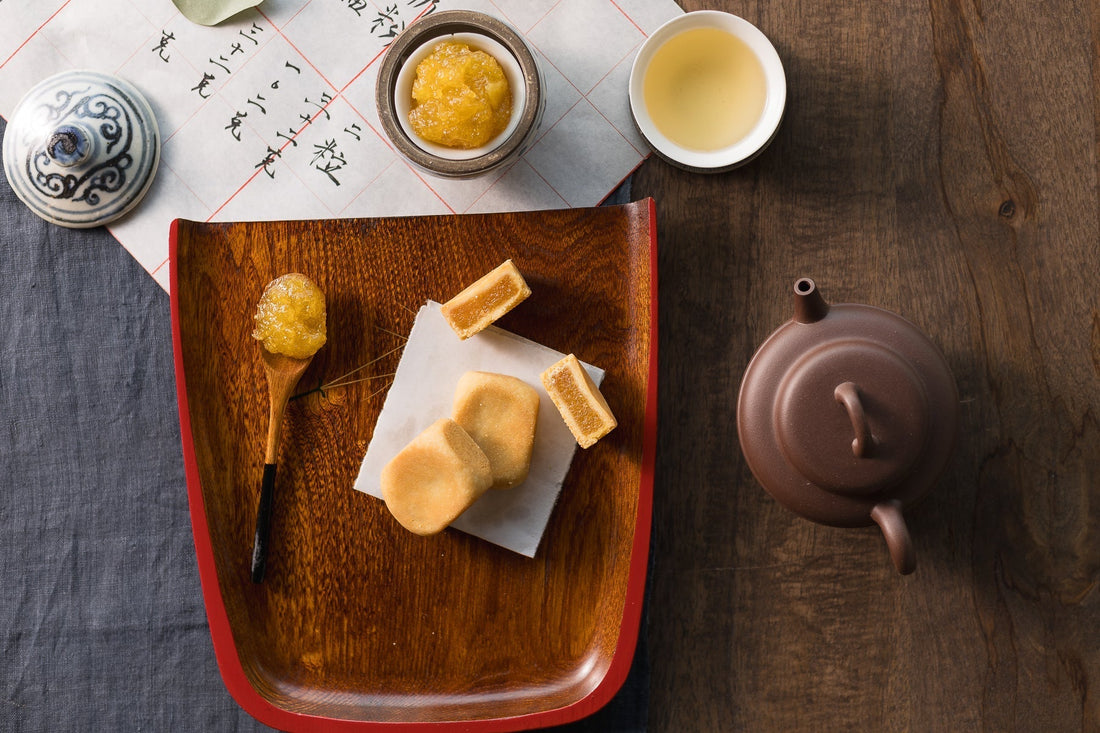
Taiwanese Pineapple Cake: History, Symbolism, and Ingredients
Have you ever tried a Taiwanese pineapple cake? A buttery crust meets a jam-filled center, making it the best companion for tea. Beyond taste, it's a cultural icon in Taiwan.
Pineapple cakes (Chinese: 鳳梨酥; pinyin: fèng lí sū;) are delicious and an essential emblem of Taiwanese culture. These little cakes have become synonymous with Taiwan- they are given as gifts, celebrated at festivals, and perfected in bakeries across the country.
The Culinary Symbol of Taiwan
The pineapple is an important culinary symbol in Taiwan. In the Hokkien dialect of Taiwanese, the word pineapple (ong lai) means ‘prosperity arrives’, making the fruit a symbol of luck, success, and fortune.
Pineapple cake usually contains simple ingredients such as butter, flour, sugar, egg and pineapple, and often winter melon may be added. The cake is closer to a scone or shortbread in texture, and the filling is usually sweet and slightly tangy. This combination pleases the palates of locals and international tourists alike.
History of Taiwanese Pineapple Cakes
When you think of pineapple, do you think of Taiwan? While not native to the area, the pineapple was introduced to Taiwan in the 16th century, brought over by Portuguese merchants. The climate of Taiwan proved to be a successful growing environment for the fruit. The growing area is mostly in southern Taiwan, in Pintung county.
Evolution of the Cake
The original pineapple cakes created from the locally grown fruit were different from the ones we see today. Symbolizing fortune and good luck, the cakes were quite large and reserved for royalty and the wealthy class, often presented at weddings. Over time and an abundance of pineapple fruit, the pastry has been adapted into more miniature cakes more accessible for the general population.
The Japanese Influence
The fruit’s popularity grew during the Japanese colonialization of Taiwan (1895-1945). The Japanese government wanted to turn Taiwan into a “model colony” and there was a huge focus on increasing the growing industry in the small country. Numerous pineapple processing plants were developed, and the pineapple export industry exploded.

Modern Pineapple Cake Birth
By the 1930s, Taiwan was the third-largest pineapple exporter. Post-Japanese occupation, with abundant domestic pineapple consumption, culinary experts innovated with the pineapple surplus. Thus, the modern pineapple cake emerged! A unique way to honor the revered pineapple.
Such is the love for pineapple cake that the Taipei Government initiated an annual Taipei Pineapple Cake Cultural Festival. This event boosts tourism, with a contest where bakers fuse unconventional ingredients like rice, Taiwanese tea, and various fruits. This festivity amplifies bakery sales and pineapple cake's global demand.
Symbolism of Taiwanese Pineapple Cakes
In Taiwan, the pineapple epitomizes luck and prosperity. Traditionally, pineapple cakes were coveted wedding gifts. Today, they symbolize wishes for a prosperous family and a sweet future. Surpassing even the popularity of mooncakes during the Lunar New Year, the pineapple cake is a testament to an auspicious year. From special occasions to everyday hospitality, pineapple cakes are a staple gesture of friendship and gratitude.
Pineapple Cakes Varieties
Typically square or rectangular, pineapple cakes can, however, vary by region. Sometimes, they resemble a small round cake or a tart. Bakers introduce creative nuances in the fillings. While pineapple remains the core ingredient, traditional versions often include winter melon.
Modern cakes might be exclusively pineapple, but at Té Company, we favor the addition of winter melon. Bakers also experiment with fillings like nuts, other fruits, and the classic salted egg yolk. Each variant is a culinary adventure waiting to be explored.



Making Taiwanese Pineapple Cakes
Taiwanese pineapple cakes basically have two components, the pastry dough, and the jam filling.
Ingredients








Buy Taiwanese Pineapple Cakes
Taiwanese pineapple cakes are more than just a treat; they're a cultural hallmark, a symbol of tradition, and a taste of nostalgia for every Taiwanese individual.
Emblematic of good fortune, and hospitality, they are a testament to Taiwan's rich heritage. Featured in the New York Times, you can get ours either in-person at our tearoom or via an online order.
Taiwan Pineapple Cake FAQ
What are Taiwanese Pineapple Cakes?
It's a key part of Taiwanese culture, made of a buttery crust with a jam-filled middle. They're usually square or rectangular but can be round in some regions. Pineapple is the main ingredient, and winter melon is often added in traditional recipes.
How are Taiwanese Pineapple Cakes Made?
They have two main parts: the dough and the jam. The jam is cooked down in a pan, and the dough, similar to a basic short-crust, includes milk powder for extra flavor. After shaping, they're baked until they turn golden.
What is the significance of pineapple cake?
In the Hokkien dialect, "ong lai" means 'prosperity arrives'. This makes the pineapple a symbol of good luck in Taiwan. These cakes used to be given at weddings as gifts. Now, they're both special occasion treats and everyday tokens of thanks.
Where to Find Authentic Taiwanese Pineapple Cakes?
Visit Té Company for the real deal. Our version includes winter melon, giving a unique taste. We also offer Taiwanese teas that go well with these cakes.
How to Enjoy Taiwanese Pineapple Cakes?
Pair a Taiwanese pineapple cake with a hot cup of tea, best if it's Taiwanese. The mix of the crust and jam inside offers a tasty experience with cultural roots. Enjoy each piece and think of its tradition.
